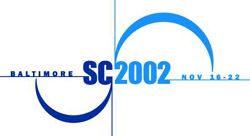OSC-Springfield Fills Its Research Positions in Record Time
Since opening its offices in March 2004, Ohio Supercomputer Center-Springfield (OSC-Springfield) has filled eight of its nine projected positions, including senior and junior networking researchers and systems specialists.
According to Project Director Kevin Wohlever, OSC-Springfield will fill 12 positions by year-end, totaling 30 jobs by the end of 2005.
 For the past 14 years, OSC (Ohio Supercomputer Center) has made a place for itself in the world of high performance networking and computing. This year will be no exception when OSC showcases recent projects at Supercomputing 2002 (SC2002), an annual weeklong national supercomputing conference. SC2002 will be held at the Baltimore Convention Center on November 16-22.
For the past 14 years, OSC (Ohio Supercomputer Center) has made a place for itself in the world of high performance networking and computing. This year will be no exception when OSC showcases recent projects at Supercomputing 2002 (SC2002), an annual weeklong national supercomputing conference. SC2002 will be held at the Baltimore Convention Center on November 16-22.